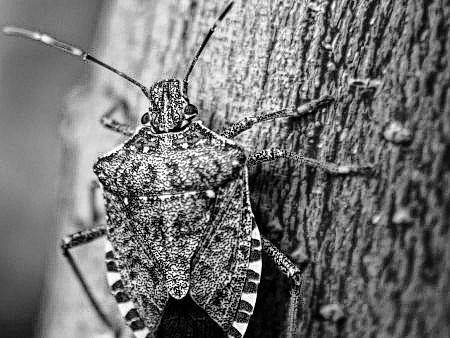
COLUMBUS – When Celeste Welty unzips the white, nylon cage, none of the stink bugs inside move.
“They’re very tranquil,” she says.
Why wouldn’t they be? Inside their cage, they enjoy spa-like conditions with all the sunflower seeds and nuts they can feed on, the warmth of the sunlight coming through the window beside them and a few house plants to make it feel like the outdoors, though they’re in a lab.
Young offspring clutch the walls of a separate cage inside what appears to be a refrigerator but instead is a warming chamber.
Such special treatment for the brown marmorated stink bug, which farmers despise and homeowners often flick out of the way when they discover them indoors during the cold months.
Thriving on a range of fruits and vegetables, the marmorated stink bug has damaged or destroyed enough crops in Ohio and across the United States to get the attention of entomologists nationwide.
Welty, an Ohio State University Extension entomologist, is involved in a 15-state study to determine the best, and ideally natural, way to get rid of the marmorated stink bug. The study is one of several being done on stink bugs through Ohio State’s College of Food, Agricultural, and Environmental Sciences.
Invasive species
The brown marmorated stink bug is a foreigner to the United States, and in the absence of natural predators here, its populations are exploding, particularly in the mid-Atlantic region. Arriving in the U.S. from China, the grayish brown bug was first detected in Allentown, Pa. in 2001. Six years later, one was reported in Ohio. Known hotspots for the insect in Ohio are Columbus, Cincinnati, Marietta, Dayton and Youngstown.
How the first brown marmorated stink bug got to the U.S. is unclear, but often it is carried through boxes or packages, a hitchhiker of sorts, Welty said.
“They like to nestle down into protected, narrow spaces, and that’s often present in packing materials,” she said. “That’s why they’re known to go in cargo and hang out.”
Three years ago, a grower in eastern Ohio ordered a shipment of snow fencing, the perforated plastic fencing that comes in large rolls. When the grower unrolled the fencing sent from Pennsylvania, he found live stink bugs sprinkled throughout.
Finding natural enemies
From Welty’s colony of marmorated stink bugs, she takes the eggs and places them outside the lab on plant leaves. Two days later when she retrieves them, she hopes some have been attacked by the bug’s natural predator, the tiny Trissolcus japonicus wasp. Also a native of China, the wasp was detected in the United States in 2014 and has since been found in eight states but not yet in Ohio. And nowhere in the U.S. is it plentiful – at least not plentiful enough to keep down the marmorated stink bug population.
“The wasp appears to be spreading on its own, but it’s so early on in the introduction of the wasp that we really don’t know,” Welty said.
Welty and entomologists across the U.S. are hoping to happen upon some T. japonicus wasps in their states.
“We’ve known for a number of years now that this one species of wasp would be great to have,” Welty said. “The stink bug is a terrible pest in agricultural crops, and we want to know how to control it with more sustainable methods than just spraying a lot.”
Study on stink bugs that seize on soybeans
A second major stink bug study being done through the college examines the effect of stink bugs on soybeans in Ohio. Entomology Associate Professor Andy Michel is leading the research into the species of stink bugs that prey on soybeans: the green, the brown, the red shouldered and the brown marmorated stink bug.
Michel is on the second year of a three-year project funded by the Ohio Soybean Council and the North Central Soybean Research Program to determine what species of stink bugs cause the most damage to soybeans and how prevalent the bugs should be before spraying.
Seizing on developing soybean seeds, stink bugs attack the plant using their wide and sharp mouths, which extend to nearly half the length of their bodies.
“They pierce through the pod, go on to the seed, then add enzymes and saliva to suck up the nutrients,” Michel said. “In the end, it looks like a shriveled up, brown, discolored seed.”
Often this damage is not apparent until harvest, because the pod usually retains its shape, despite the smaller seed. That makes it important to scout early for stink bugs and control them if necessary, Michel said.
Drought conditions encourage the spread of stink bugs so unusually dry summers including 2016 and 2012, saw some of the state’s worst infestations, Michel said.
In one soybean field, stink bugs caused a 30 percent yield loss in 2012.
Hard to spot, hard to catch
Stink bugs of any species can be tricky to spot outdoors. They hide well – stationing themselves on the underside of leaves and the back side of flowers. They’re easy to miss, that is, until they come indoors and drop from a ceiling down onto a table. Try to squish them with your hands and they’ll leave you with a parting gift: a smelly stain on your skin that can’t easily be washed off.
“We’re not necessarily looking to defeat the stink bug. I think what we’re looking for is an integrated way to manage the bug. Just because you have stink bugs in your field doesn’t mean you need spray,” Michel pointed out.
That’s because stink bugs could develop a resistance to pesticides, some stink bugs don’t cause as much harm to soybeans as others and some species are actually beneficial, being natural enemies of other soybean pests.
“We want growers to be able to identify stink bug species and determine when their field is at risk for economic damage,” Michel said, “and therefore when they should start spraying.”


